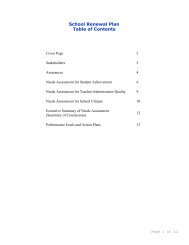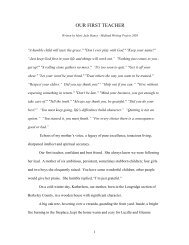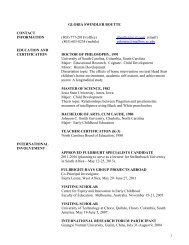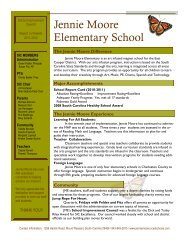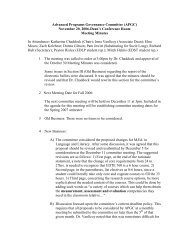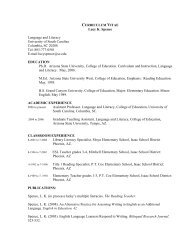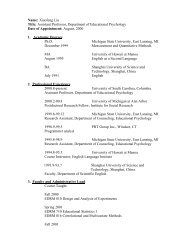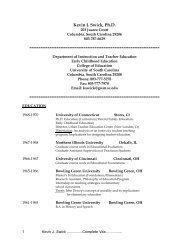The SAS® Macro MIXED_DX - CiteSeerX
The SAS® Macro MIXED_DX - CiteSeerX
The SAS® Macro MIXED_DX - CiteSeerX
Create successful ePaper yourself
Turn your PDF publications into a flip-book with our unique Google optimized e-Paper software.
SAS Global Forum 2010<br />
Paper 201-2010<br />
Fundamental Diagnostics for Two-Level Mixed Models: <strong>The</strong> SAS ® <strong>Macro</strong> <strong>MIXED</strong>_<strong>DX</strong><br />
ABSTRACT<br />
Bethany A. Bell, Jason A. Schoeneberger, Grant B. Morgan<br />
University of South Carolina<br />
Jeffrey D. Kromrey, John M. Ferron<br />
University of South Florida<br />
Multilevel modeling has become a common analytic technique across a variety of disciplines including medicine and<br />
the social and behavioral sciences. However, because many researchers who use multilevel modeling in their<br />
research do not report if the data were screened for potential violations of distributional assumptions and outliers, it is<br />
unclear if these diagnostic procedures are being conducted. Thus, in an effort to make the process of checking the<br />
assumptions for multilevel models easier for the applied researcher, this paper provides a SAS macro for conducting<br />
two-level linear model diagnostics, including examinations of residual normality, linearity, homogeneity of variance,<br />
and influential outliers. By utilizing data from PROC <strong>MIXED</strong> ODS tables, the macro produces box-and-whisker plots,<br />
summary tables of statistical output, histograms, and plots of residuals by predicted values. <strong>Macro</strong> outputs are<br />
produced for both level-1 and level-2 data. This paper provides a discussion about the distributional assumptions of<br />
mixed models, an example of the macro language, and results from an executed example of the macro. Information<br />
for downloading the complete macro is also provided.<br />
Keywords: MULTILEVEL MODELING, STATISTICAL ASSUMPTIONS, INFLUENCE DIAGNOSTICS, PROC <strong>MIXED</strong>,<br />
SAS MACRO<br />
INTRODUCTION<br />
As multilevel modeling techniques (also called hierarchical linear modeling or mixed modeling) continue to be used<br />
with increasing frequency across a variety of disciplines, it is important for researchers to conduct appropriate model<br />
diagnostics when using these statistical methods. Like most parametric statistical procedures, there are certain<br />
distributional assumptions underlying the validity of the Type I error control when conducting multilevel analyses.<br />
Thus, just as researchers were trained to evaluate the underlying assumptions for multiple regression and ANOVA,<br />
they, too, need to assess and report on the assumptions associated with multilevel models. Although most of the<br />
assumptions associated with two-level linear models are similar to OLS model assumptions (i.e., residual normality,<br />
linearity, and homogeneity of variance), few articles in which multilevel modeling techniques are used contain this<br />
information, despite recommendations to be transparent when reporting multilevel modeling research processes and<br />
findings (Ferron, Hogarty, Dedrick, Hess, Niles, & Kromrey, 2008).<br />
One likely reason for the omission of this information could be related to the cumbersome nature of conducting model<br />
diagnostics of two-level linear models. First, it is not easy to locate all of the data necessary to conduct diagnostics for<br />
both level-1 and level-2 residuals. For example, the level-1 and level-2 residuals are stored in two different ODS<br />
tables, which not only have to be requested separately, but the commands necessary to request each ODS table<br />
occurs at two different places within the PROC <strong>MIXED</strong> code (i.e., the ODS table for level-1 residuals is an option that<br />
can be added to the model statement whereas the ODS table for level-2 residuals is requested through an ODS<br />
OUTPUT command). Second, the ODS table that contains the level-2 residuals does not contain predicted values for<br />
level-2 units. Thus, the data must be manipulated to generate these values. Third, although PROC <strong>MIXED</strong> does allow<br />
the INFLUENCE option on the model statement, the oodles of data produced by this option can be overwhelming,<br />
especially to a novice PROC <strong>MIXED</strong> user. Thus, in an effort to reduce the burden of conducting these important, yet<br />
unwieldy, analyses this paper provides a SAS macro to conduct diagnostic evaluations of two-level linear models,<br />
including examinations of residual normality, linearity, homogeneity of variance, and influential outliers. Diagnostics<br />
are conducted for both level-1 and level-2 data and the macro includes the data screening techniques recommended<br />
by authors such as Hox (2002), Longford (2001), and Raudenbush and Bryk (2002).<br />
STATISTICAL ASSUMPTIONS AND THEIR EVALUATION<br />
Raudenbush and Bryk (2002) correctly assert that the validity of inferences based on models depend on the degree<br />
to which assumptions are upheld about the structural and random parts of the model. <strong>The</strong>y go on to suggest that<br />
“skillful analysts pay close attention to the assumptions required by their models” (p. 253). Unfortunately, based on<br />
reporting practices, it seems that the assumptions frequently go unexamined or under-examined by analysts<br />
conducting multilevel modeling (Ferron et al., 2008). However, it is not clear if this common omission is a function of a<br />
lack of understanding or the effort and time needed to assess model adequacy. This work seeks to address the latter<br />
issue by facilitating the generation of information necessary to assess to the tenability of the model assumptions.<br />
1<br />
Posters
SAS Global Forum 2010<br />
Under Ordinary Least Squares (OLS) regression, the error terms are assumed to be normally distributed,<br />
independent, and homoscedastic. <strong>The</strong>se same assumptions apply to linear multilevel models. In particular, the<br />
assumption of normally distributed errors must be made for both level-1 and level-2 variables, with violations<br />
adversely affecting level-2 estimated standard errors and inferential statistics (Raudenbush & Bryk, 2002). <strong>The</strong><br />
effects of the violation at level-1 may include distorted random effect coefficients and variance-covariance<br />
components. To examine the distribution of the errors, data analysts should consider the following options. First, one<br />
might plot the standardized residuals against their normal scores to observe how closely the plot follows a diagonal<br />
line (Hox, 2002). Second, to assess the distribution of the overall residuals at levels one and two, one might also use<br />
histograms or box-and-whisker plots. Similarly, box-and-whisker plots of the level-1 residuals for each level-2 unit and<br />
of the level-2 residuals for each level-2 effect will help assess deviations from a normal distribution and identify<br />
extreme values. Third, to assess assumptions of normality, linearity, and homogeneity of variance simultaneously,<br />
analysts should examine the plot of predicted values against the residuals. This should be done for level-1 residuals,<br />
as well as the residuals for each level-2 effect. Scatterplots that contain roughly equivalent frequencies of points<br />
above and below their mean value, with no particular structure, provide evidence that the assumptions have not been<br />
violated (Hox, 2002).<br />
To supplement the visual level-1 assumption diagnostics, summary statistics (i.e., skewness, kurtosis, variance and<br />
standard deviation, and a statistical test for normality such as the Shapiro-Wilk or Kolmogorov-Smirnov test) for level-<br />
1 residuals within each level-2 unit should also be reviewed for information regarding level-1 normality and variance<br />
homogeneity. In addition, Levene’s test can be used to assess homogeneity of variance of the level-1 residuals<br />
across each level-2 unit. Next, when evaluating the tenability of assumptions for the level-2 residuals, multivariate<br />
summary statistics such as skewness, kurtosis, and Mahalanobis distances should be generated and reviewed.<br />
Multivariate normality can also be evaluated visually through a histogram of Mahalanobis distances. And, as with the<br />
level-1 residuals, Levene’s test for assessing homogeneity of variance of the level-2 residuals can also be conducted<br />
for each level-2 effect.<br />
<strong>The</strong> <strong>MIXED</strong>_<strong>DX</strong> macro provides analysts with a comprehensive approach to assessing the degree to which one or<br />
more of the linearity, normality, or homogeneity of variance assumptions has been violated. <strong>The</strong> output includes both<br />
visual (e.g., box-and-whisker plots, histograms, scatter plots) and statistical information for both level-1 and level-2<br />
residuals. A unique feature of our macro is the calculation of level-2 predicted values for each level-2 effect. Unlike<br />
the level-1 ODS output table in SAS (generated through the outp option) that contains both residuals and predicted<br />
values for each level-1 observation, the level-2 ODS output table in SAS (SolutionR) does not contain predicted<br />
values. By calculating predicted values for each level-2 effect, our macro allows analysts to create and examine<br />
residual by predicted scatterplots for level-2 effects (something that cannot be done using the default SAS output<br />
alone). Furthermore, the <strong>MIXED</strong>_<strong>DX</strong> macro generates output for all level-2 units, with an option for a user-defined<br />
minimum of cases per level-2 unit to be included in these analyses.<br />
INFLUENCE<br />
Nearly all statistical analyses involve post-hoc diagnostic investigations to determine how well models fit the data.<br />
One of the more well-established diagnostics for ordinary least-squares linear regression is the detection of influential<br />
observations in determining parameter estimates. Previous work by Cook (1977), Belsley, Kuh, and Welsch (1980),<br />
and Andrews & Pregibon (1978) provided useful statistics for determining how much influence a particular<br />
observation had over estimated parameters or the performance of the model. With the development of more complex<br />
multilevel models, the detection of influential observations becomes more complex as well. For example, mixed<br />
model analyses generate more results than may be of potential interest to the researcher. A researcher may be<br />
interested in predicting a particular outcome variable, in which case fixed effect results are of primary interest,<br />
whereas another researcher might be interested in explaining the variance in a particular outcome, thus variance<br />
component results become the primary concern. Further, with multilevel models, the concept of influence is often<br />
applied to higher-level units (i.e., group or cluster influence) vs. with OLS diagnostics where influence diagnostics are<br />
concerned with the influence of individual observations. This interest in the influence of higher-level clusters or groups<br />
calls for set-deletion analyses where an entire cluster or group is removed to determine its influence vs. the removal<br />
of individual observations as is done in OLS diagnostic algorithms.<br />
Littell, Milliken, Stroup, and Wolfinger (2006) recommend a “drill-down” approach to mixed model influence<br />
diagnostics, beginning with a global assessment of the influence on the overall model, followed by a more detailed<br />
exploration of the case-sets should they be warranted. <strong>The</strong> likelihood distance (Cook & Weisberg, 1982) provides an<br />
assessment of a unit’s influence on the overall model. A group or unit’s influence on parameter estimates can be<br />
determined using Cook’s D or the multivariate DFFITS statistics. <strong>The</strong> larger the value for these statistics, the greater<br />
the influence a unit has on parameter estimates (i.e., the change in the parameter estimate is large relative to the<br />
variability of the estimate; Schabenberger, 2004). Researchers can also examine a unit’s effect of the precision of an<br />
estimate through the covariance trace (COVTRACE) and covariance ratio (COVRATIO) statistics. For these statistics,<br />
benchmark values used to determine a unit’s level of influence are zero and one, respectively (Schabenberger,<br />
2004). Each of these influence diagnostics can be generated for both fixed effects and covariance parameters,<br />
however calculation for the latter requires an iterative process due to the potential impact of observations on<br />
covariance matrices. <strong>The</strong> INFLUENCE option within PROC <strong>MIXED</strong> allows the researcher to utilize non-iterative or<br />
iterative diagnostics, and provides the option to control the number of iterations when re-calculating estimates and<br />
covariance matrices (Littell et. al., 2006).<br />
2<br />
Posters
SAS Global Forum 2010<br />
In addition to examining a unit’s influence on the change in parameter estimates and the change in the precision of<br />
estimates, influence on fitted and predicted values can also be examined through the Predicted Residual Sum of<br />
Squares (PRESS) statistic. <strong>The</strong> PRESS provides a comparison of the predicted marginal mean and the observed<br />
mean when the predicted value is calculated without the deleted observation in question (Schabenberger, 2004).<br />
Again, larger values suggest more influential units. Other measures of overall influence provided through the<br />
INFLUENCE option in PROC <strong>MIXED</strong> include RMSE and Restricted Likelihood Distance (RLD). RMSE values<br />
represent the model RMSE with a specific level-2 unit deleted. On the other hand, RLD functions more as an<br />
‘indicator’ statistic in that it does not convey what part of the model is likely to change given the removal of a specific<br />
level-2 unit. Instead, it suggests that the overall influence of a particular level-2 unit stands out comparatively to other<br />
level-2 units (Littell et al., 2006). To determine what model components are influenced by a given level-2 unit,<br />
analysts need to examine the individual influence statistics such as MDFFITS or COVRATIO.<br />
To facilitate detection of influential observations in a two-level linear model, the <strong>MIXED</strong>_<strong>DX</strong> macro creates a ranked<br />
summary table of the influence statistics automatically created in the SAS ODS influence table (Influence). More<br />
specifically, for each statistic provided in the summary table, the macro employs the RANK procedure to determine<br />
the percentile rank of each statistic’s value for each level-2 unit. <strong>MIXED</strong>_<strong>DX</strong> allows the user to choose a threshold<br />
percentile rank of interest for the detection of influential observations via the ‘PR = ‘ argument to the macro. <strong>The</strong><br />
default, ‘PR = 90’, will flag any level-2 unit with a percentile rank greater than 90 for each statistic included in the ODS<br />
output. To further facilitate inspection of the summary table, particularly for data sets with a large number of level-2<br />
units, we summed the number of flagged statistics and sorted the table in descending order, thus, placing level-2<br />
units most frequently identified as influential at the top of the summary table. In addition, the <strong>MIXED</strong>_<strong>DX</strong> influence<br />
output is calculated at the level-2 unit (controlled by the ‘EFFECT =’ option in Influence command in PROC <strong>MIXED</strong>)<br />
and based on five iterations (controlled by the ‘ITER =’ option in the Influence command in PROC <strong>MIXED</strong>).<br />
MACRO <strong>MIXED</strong>_<strong>DX</strong><br />
<strong>The</strong> <strong>MIXED</strong>_<strong>DX</strong> macro inputs consist of ODS table names generated from the <strong>MIXED</strong> procedure including (a)<br />
ModelInfo,, (b) Dimsensions, (c) SolutionF, (d) SolutionR, (e) Level1, and (f) Influence, as well as two user specified<br />
arguments, MIN_NJ and PR. MIN_NJ defines the smallest level-2 unit to be included in the within-unit box-andwhisker<br />
plots and normality assessments (allowing the exclusion of very small units from these analyses), whereas<br />
PR defines the threshold percentile rank of influence diagnostics that trigger the flagging of level-2 units. If the<br />
MIN_NJ subanalysis is not wanted, the user will need to override the default value of five by specifying some value<br />
for MIN_NJ such as MIN_NJ = 1.<br />
<strong>The</strong> <strong>MIXED</strong>_<strong>DX</strong> macro produces numeric (i.e., output located in the output window) and visual (i.e., output located in<br />
the graph window) output for both level-1 and level-2 data.<br />
Level-1 numeric output includes: (a) normality summary statistics table for the overall level-1 residual and for each<br />
level-2 unit, (b) normality summary statistics table for the overall level-1 residual and for each level-2 unit where nj ><br />
min_nj, (c) PROC UNIVARIATE plot output for the variance of all level-1 residuals, (d) PROC UNIVARIATE plot<br />
output for the variance of level-1 residuals where nj > min_nj, and (e) PROC GLM output providing Levene’s Test for<br />
homogeneity of variance of level-1 residuals.<br />
Level-1 visual output includes: (a) side-by-side box-and-whisker plots for the overall level-1 residual and for each<br />
level-2 unit, (b) side-by-side box-and-whisker plots for the overall level-1 residual and for each level-2 unit where nj ><br />
min_nj, (c) histogram of the variance of all level-1 residuals, (d) histogram of the variance of all level-1 residuals<br />
where nj > min_nj, and (e) plot of level-1 residuals by predicted values.<br />
Level-2 numeric output includes: (a) PROC GLM output providing Levene’s Test for homogeneity of variance of level-<br />
2 residuals for both the intercept and slope (when applicable) for each level-2 effect, (b) PROC UNIVARIATE plot<br />
output of level-2 residuals for each level-2 effect, (c) multivariate normality and outlier summary table, (d)<br />
Mahalanobis distance values for level-2 units, (e) PROC UNIVARIATE plot output of Mahalanobis distance values for<br />
level-2 units, and (f) table of ranked influence diagnostics.<br />
Level-2 visual output includes: (a) plot of level-2 residuals by predicted values for each level-2 effect, (b) histogram of<br />
level-2 residuals for each level-2 effect, and (c) histogram of Mahalanobis distance values.<br />
Below is important information about the types of models that are supported by macro <strong>MIXED</strong>_<strong>DX</strong>:<br />
A. <strong>MIXED</strong>_<strong>DX</strong> has been tested for use in SAS 9.1.3 and 9.2<br />
B. <strong>MIXED</strong>_<strong>DX</strong> utilizes the following SAS components: Base SAS, SAS/STAT, SAS/GRAPH, and SAS/IML<br />
C. <strong>MIXED</strong>_<strong>DX</strong> works for 2-level linear multilevel models estimated in PROC <strong>MIXED</strong><br />
D. <strong>MIXED</strong>_<strong>DX</strong> works correctly for models that have converged and have positive definite G-matrices<br />
E. <strong>MIXED</strong>_<strong>DX</strong> is designed to read model effect names up to 32 characters in length. If a user has an effect that is<br />
longer than 32 characters, the 'NAMELEN= ' option in PROC <strong>MIXED</strong> must be updated accordingly.<br />
F. If a user's model contains any interactions, they must be created on the model statement (e.g., model y=x1 x2<br />
w1 w2 x1*w1)<br />
G. Users cannot use the class statement to create dummy variables in PROC <strong>MIXED</strong>. That is, any dummy<br />
variables used in the model statement need to be created prior to the <strong>MIXED</strong> procedure (e.g., in a data step).<br />
3<br />
Posters
SAS Global Forum 2010<br />
H. Users need to specify their desired value for MIN_NJ, which defines the smallest level-2 unit to be included in<br />
the within-unit box-and-whisker plots and normality assessments. <strong>The</strong> default is set to 5. Even if this subanalysis<br />
is not wanted, the user must override the default value of 5 and specify some value for MIN_NJ such as min_nj =<br />
1.<br />
I. For nominal level-2 effects that include multiple dummy vectors, users need to specify the dummy vector<br />
variable names, as they are listed in the PROC <strong>MIXED</strong> model statement, separated by spaces, for the ‘GroupVar<br />
=’ argument to the macro; the default is ‘none’. Only one set of dummy vectors can be entered for the ‘GroupVar’<br />
argument; if the PROC <strong>MIXED</strong> model statement contains more than one level-2 multi-group variable that has<br />
been dummy coded, the macro needs to be run separately for each of these effects to generate the Levene’s<br />
Test for homogeneity of variance for each specific multi-group level-2 effect. If the PROC <strong>MIXED</strong> model<br />
statement does not include any level-2 dummy coded variables, then the user needs to keep the default value of<br />
‘none’.<br />
J. Users need to specify their desired value for PR, which defines the threshold percentile rank of influence<br />
diagnostics that trigger the flagging of level-2 units. <strong>The</strong> default is set to 90.<br />
<strong>The</strong> most current version of the complete <strong>MIXED</strong>_<strong>DX</strong> SAS program file is available for download from<br />
http://www.ed.sc.edu/bell/ .<br />
EXAMPLE OF MACRO <strong>MIXED</strong>_<strong>DX</strong><br />
Below is an example of PROC <strong>MIXED</strong> code used in conjunction with the macro <strong>MIXED</strong>_<strong>DX</strong>, followed by select<br />
examples of the numeric and visual output.<br />
ods exclude influence SolutionR;<br />
title;<br />
proc mixed data = temp covtest noclprint NAMELEN=32;<br />
class schoolid;<br />
model mathach = SIZE FEMALE SES MEANSES SES*MEANSES SES*SIZE<br />
FEMALE*SIZE/ solution outp=L1Resid influence(effect=schoolid iter=5);<br />
random intercept FEMALE SES / sub=schoolid solution type=un;<br />
ods output SolutionR=L2Resid SolutionF=Fixed ModelInfo=ModelStuff<br />
Dimensions=DatStuff Influence=influence; run;<br />
%mixed_dx (ModelI = modelstuff, Dims = datstuff, solnF = Fixed, solnR =<br />
L2Resid, Level1 = L1Resid, Influence = influence, min_nj = 5, pr = 90,<br />
GroupVar = None); run;<br />
<strong>MIXED</strong>_<strong>DX</strong> VISUAL OUTPUT<br />
Figure 1 contains one ‘window’ of the level-1 residual box-and-whisker plot output for the overall level-1 residual (the<br />
first plot in the series) and for each level-2 unit. <strong>The</strong>se plots can be used to evaluate the normality and heterogeneity<br />
of variance assumption for the overall level-1 residual, as well as for the level-1 residuals within each level-2 unit.<br />
Figure 2 contains similar output as Figure 1, however, instead of including box-and-whisker plots for all level-2 units,<br />
the output in Figure 2 displays the overall level-1 residual and the residuals for level-2 units in which nj ≥ 5 , where<br />
the sample size of five was specified through the MIN_NJ = 5 option in the call to the macro. As with Figure 1, the<br />
box-and-whisker plots included in Figure 2 allow an analyst to evaluate the tenability of the normality and<br />
heterogeneity of variance assumptions for level-1 residuals. However, instead of examining level-1 residuals within<br />
each level-2 unit, this part of the <strong>MIXED</strong>_<strong>DX</strong> output is limited to level-2 units with a user specified minimum number of<br />
observations. This approach allows users to focus on level-2 units with enough observations that normality and equal<br />
variances might be plausible (i.e., when level-2 units do not have many observations in them, normally distributed<br />
errors and equal variances with other, more dense level-2 units is highly improbable given the tenets of Central Limit<br />
<strong>The</strong>orem).<br />
<strong>The</strong> histogram displaying the distribution of the variance of level-1 residuals for all level-2 units shown in Figure 3<br />
provides users with summary information regarding the magnitude of level-1 residual variances across level-2 units.<br />
Although this part of the output is not directly related to evaluating the heterogeneity of variance assumption for level-<br />
1 residuals, it offers supplemental information regarding the nature of the variability in level-1 residuals. Figure 4<br />
displays the plot of level-1 residuals by predicted values for all observations included in the PROC <strong>MIXED</strong> analysis.<br />
Similarly, Figures 5 and 6 contain plots of level-2 residuals by predicted values for the intercept and the random effect<br />
for the level-1 variable ‘female’ (i.e., level-2 effect = female), respectively. Each scatterplot provides users a way to<br />
evaluate simultaneously the normality, linearity, and homoscedasticity of level-1 (Figure 4) and level-2 residuals<br />
(Figures 5 and 6).<br />
Figure 7 contains a histogram displaying the distribution of Mahalanobis distance values for each level-2 unit which<br />
allows researchers to easily examine the range of values to determine if potentially problematic outliers are evident.<br />
4<br />
Posters
SAS Global Forum 2010<br />
Moreover, when evaluating data for possible outliers or violations of statistical assumptions, nicely summarized<br />
distributions such as the histogram in Figure 7 are particularly helpful and efficient when there are oodles of level-2<br />
units.<br />
Figure 1. Distribution of level-1 residuals: Overall residual and for each level-2 unit<br />
Figure 2. Distribution of level-1 residuals: Overall residual and for each level-2 unit where nj ≥ 5<br />
5<br />
Posters
SAS Global Forum 2010<br />
Figure 3. Distribution of the variance of level-1 residuals for all observations<br />
Figure 4. Level-1 residual*predicted value for all observations<br />
6<br />
Posters
SAS Global Forum 2010<br />
Figure 5. Level-2 residual*predicted intercept value for all level-2 units<br />
Figure 6. Level-2 residual*predicted random effect for level-1 variable ‘female’ for all level-2 units<br />
7<br />
Posters
SAS Global Forum 2010<br />
Figure 7. Distribution of Mahalanobis distance values for each level-2 unit<br />
<strong>MIXED</strong>_<strong>DX</strong> NUMERICAL OUTPUT<br />
Figures 8, 9, 10, 11, and 12 contain different elements of the numerical output generated by <strong>MIXED</strong>_<strong>DX</strong>. Specifically,<br />
Figure 8 is one ‘window’ of the normality summary table for level-1 residuals, Figure 9 contains the PROC GLM<br />
output for Levene’s test of homogeneity of variance of level-1 residuals, Figure 10 includes PROC GLM output for the<br />
Levene’s test of homogeneity of variance of level-2 residuals of the variable ‘Size’, Figure 11 includes the level-2<br />
multivariate normality and outlier assessment table, and Figure 12 includes one ‘window’ of the ranked influence<br />
diagnostic summary table for level-2 units. <strong>The</strong> statistical output provided in the normality summary table for level-1<br />
residuals (Figure 8) can be used to supplement the visual evaluation of the normality and homogeneity of variance<br />
assumption of level-1 residuals. Similarly, the Levene’s test of homogeneity of variance output provided in Figures 9<br />
and 10 can also be used to supplement any visual assessment of equal variances of (a) level-1 residuals across<br />
level-2 units and (b) level-2 intercept and slope residuals, respectively. <strong>The</strong> statistical output in Figure 11 allows users<br />
a method of evaluating the multivariate normality of level-2 residuals. Also, results from the inferential examination of<br />
the largest Mahalanobis distance can be used to supplement the visual evaluation of potentially problematic outliers.<br />
By providing a nice summary of the influential nature of each level-2 unit, the ranked influence diagnostics output in<br />
Figure 12 provides users a way to easily examine which, if any, level-2 units might be influencing the magnitude or<br />
precision of fixed and/or random effects in their model.<br />
CONCLUSIONS<br />
<strong>The</strong> macro <strong>MIXED</strong>_<strong>DX</strong> was created to facilitate the evaluation of statistical assumptions of linear two-level multilevel<br />
models, including the examination of residual normality, linearity, and homogeneity of variance, as well as influential<br />
outliers. By utilizing data provided in various ODS tables in PROC <strong>MIXED</strong>, <strong>MIXED</strong>_<strong>DX</strong> makes it much easier for the<br />
applied data analyst to evaluate assumptions for both level-1 and level-2 residuals, through both numeric and visual<br />
assessments such as statistical summary tables, box-and-whisker plots, histograms, and plots of residuals by<br />
predicted values. Furthermore, <strong>MIXED</strong>_<strong>DX</strong> is easily modifiable. For example, users can add to the macro to invoke<br />
procedures that are not currently included, such as examining the distribution of level-2 sample sizes. Conversely,<br />
users can also easily comment out any unwanted elements of the macro. Thus, given the ease in calling the macro<br />
when estimating two-level linear models via PROC <strong>MIXED</strong>, we hope that more researchers will not only evaluate the<br />
distributional assumptions and outliers, but also report said evaluations in their published research.<br />
8<br />
Posters
SAS Global Forum 2010<br />
Normality summary statistics for the overall residual and each level-2 unit<br />
Level-2 Unit Skewness Kurtosis Shapiro-Wilk p-value Variance Std Dev N<br />
Overall -0.1464 -0.5220 0.0321 0.0100 35.6292 5.9690 7185<br />
1224 0.2481 -1.1449 0.9375 0.0143 54.4537 7.3793 47<br />
1288 -0.4288 -0.6287 0.9475 0.2206 46.0958 6.7894 25<br />
1296 0.6568 1.3472 0.9562 0.0711 28.5501 5.3432 48<br />
1308 -0.3487 -0.5644 0.9483 0.3423 38.2406 6.1839 20<br />
1317 0.1423 -0.8975 0.9604 0.1052 29.4795 5.4295 48<br />
1358 -0.4556 0.2699 0.9683 0.4938 25.4989 5.0496 30<br />
1374 -0.3089 -0.7325 0.9599 0.3471 61.3113 7.8302 28<br />
1433 -0.4066 -0.7341 0.9572 0.1883 13.8575 3.7226 35<br />
1436 -0.7585 0.1641 0.9476 0.0450 17.8752 4.2279 44<br />
1461 -1.4369 2.4512 0.8717 0.0011 34.2199 5.8498 33<br />
1462 0.5766 -0.4901 0.9467 0.0139 41.0545 6.4074 57<br />
1477 -0.4332 -0.7634 0.9522 0.0171 50.5179 7.1076 62<br />
1499 0.6850 0.0731 0.9523 0.0337 32.1495 5.6701 53<br />
1637 0.7102 -0.0295 0.9374 0.1050 45.9021 6.7751 27<br />
1906 -0.5982 -0.1637 0.9573 0.0561 40.8894 6.3945 53<br />
1909 -0.2498 -1.3750 0.9193 0.0333 34.4495 5.8694 28<br />
1942 -0.9756 0.7643 0.8972 0.0084 30.7441 5.5447 29<br />
1946 0.0692 -1.1729 0.9503 0.0843 39.2686 6.2665 39<br />
2030 -0.0596 -0.7441 0.9765 0.4578 38.4415 6.2001 47<br />
2208 -0.2361 -1.1965 0.9445 0.0087 33.6639 5.8021 60<br />
2277 0.5186 -0.3404 0.9664 0.0916 33.4067 5.7799 61<br />
2305 -0.5484 -0.0718 0.9647 0.0541 26.2418 5.1227 67<br />
2336 -0.5344 -0.2465 0.9653 0.1742 32.5628 5.7064 47<br />
2458 0.1452 -1.1178 0.9484 0.0167 30.7462 5.5449 57<br />
2467 0.1245 -0.5803 0.9855 0.7739 44.0580 6.6376 52<br />
2526 -0.5742 -0.1631 0.9460 0.0130 23.5049 4.8482 57<br />
2626 -0.0066 -0.8930 0.9711 0.4212 30.8799 5.5570 38<br />
2629 -0.4906 0.0390 0.9707 0.1803 27.7982 5.2724 57<br />
2639 0.5922 0.0269 0.9667 0.2544 36.6968 6.0578 42<br />
2651 -0.0105 -0.5696 0.9825 0.8043 39.6750 6.2988 38<br />
2655 -0.1188 -0.9960 0.9674 0.1643 31.3419 5.5984 52<br />
2658 -0.1122 -0.4767 0.9887 0.9346 29.0280 5.3878 45<br />
2755 -0.4818 -0.7205 0.9536 0.0602 37.3001 6.1074 47<br />
2768 0.2829 -0.2105 0.9819 0.9205 42.1063 6.4889 25<br />
2771 0.1278 -0.7310 0.9700 0.1845 43.4792 6.5939 55<br />
2818 -0.1103 -1.2276 0.9533 0.0849 27.7784 5.2705 42<br />
2917 0.1837 -0.7458 0.9711 0.3458 49.9826 7.0698 43<br />
2990 -0.8184 0.3007 0.9410 0.0177 18.3683 4.2858 48<br />
2995 0.1756 -1.0986 0.9563 0.0825 51.9669 7.2088 46<br />
3013 -0.3269 -0.9800 0.9541 0.0406 44.7080 6.6864 53<br />
3020 -0.6004 0.2804 0.9745 0.2490 39.1896 6.2602 59<br />
3039 -0.5377 0.4199 0.9710 0.7551 24.8429 4.9843 21<br />
3088 0.0755 -0.8858 0.9691 0.3519 35.4447 5.9535 39<br />
3152 -0.6367 -0.0941 0.9455 0.0188 46.7917 6.8404 52<br />
3332 -0.0922 -0.8857 0.9646 0.2673 41.5297 6.4444 38<br />
3351 0.1423 -0.8422 0.9773 0.6059 44.7192 6.6872 39<br />
3377 0.2254 -0.6960 0.9772 0.5098 52.4213 7.2403 45<br />
3427 -0.5809 -0.6186 0.9375 0.0118 14.0454 3.7477 49<br />
Figure 8. Partial output from <strong>MIXED</strong>_<strong>DX</strong> normality summary table for level-1 residuals: Overall and for each level-2<br />
unit<br />
9<br />
Posters
SAS Global Forum 2010<br />
Levenes test of homogeneity of variance of level-1 residuals<br />
<strong>The</strong> GLM Procedure<br />
Dependent Variable: Absolute_resid (Absolute value of level-1 residual)<br />
Sum of<br />
Source DF Squares Mean Square F Value Pr > F<br />
Model 159 3269.56971 20.56333 1.85 F<br />
SCHOOLID 159 3269.569707 20.563331 1.85 F<br />
SCHOOLID 159 3269.569707 20.563331 1.85 F<br />
Model 4 7.4023303 1.8505826 2.08 0.0867<br />
Error 155 138.2284266 0.8917963<br />
Corrected Total 159 145.6307569<br />
R-Square Coeff Var Root MSE Absolute_resid Mean<br />
0.050829 79.02124 0.944350 1.195058<br />
Source DF Type I SS Mean Square F Value Pr > F<br />
D_Predict 4 7.40233027 1.85058257 2.08 0.0867<br />
Source DF Type III SS Mean Square F Value Pr > F<br />
D_Predict 4 7.40233027 1.85058257 2.08 0.0867<br />
Figure 10. <strong>MIXED</strong>_<strong>DX</strong> output for Levene’s homogeneity of variance test of level-2 residuals of the variable<br />
‘size’<br />
10<br />
Posters
SAS Global Forum 2010<br />
Multivariate normality and outlier assessment<br />
---------------------------------------------<br />
Multivariate Skewness:<br />
b1p = 0.45811311<br />
Chi-Square = 12.5624477<br />
df = 10<br />
p-value = 0.24917459<br />
Multivariate Kurtosis:<br />
b2p = 14.7863678<br />
Z (Upper) = -0.2466812<br />
p-value (Upper) = 0.59742254<br />
Z (Lower) = -0.6775666<br />
p-value (Lower) = 0.24902327<br />
Largest Mahalanobis Distance:<br />
Level 2 Unit = 3427<br />
D-Squared = 13.135085<br />
F = 4.71470232<br />
df numerator = 3<br />
df denominator = 156<br />
p-value 0.00353276<br />
Figure 11. <strong>MIXED</strong>_<strong>DX</strong> output for level-2 multivariate<br />
normality and outlier assessment<br />
Ranked influence diagnostics<br />
C C<br />
M o o<br />
S C C D v v<br />
C M o o C F R T<br />
H D v v o F a r<br />
O f P F R T o I t a<br />
O l N I R F a r k T i c R<br />
O L a o t E I t a D S o e M R<br />
b I g b e S T i c C C C C S L<br />
s D s s r S S o e P P P P E D<br />
1 3427 8 49 2 2406.76 0.01810 0.8530 0.1512 0.53129 0.60558 0.7554 0.2546 6.05025 0.7456<br />
2 8367 8 14 2 1244.06 0.02893 0.8735 0.1305 0.25961 0.30125 0.7396 0.2786 6.03687 0.4877<br />
3 2277 7 61 2 2273.07 0.04285 0.9057 0.0948 0.25883 0.28665 0.7984 0.2094 6.04184 0.6579<br />
4 2305 7 67 2 2192.31 0.02412 0.9872 0.0110 0.12724 0.12935 0.9405 0.0570 6.04602 0.3455<br />
5 6074 7 56 2 2990.11 0.02145 0.9742 0.0239 0.12442 0.13011 0.9222 0.0756 6.03473 0.3118<br />
6 2655 6 52 2 2623.47 0.04934 1.0959 0.0982 0.13220 0.14074 0.9957 0.0044 6.03880 0.5516<br />
7 6990 6 53 2 2177.66 0.02582 0.9600 0.0364 0.18515 0.20090 0.9699 0.0234 6.04228 0.3824<br />
8 3533 5 48 2 2500.44 0.01383 0.9214 0.0779 0.29336 0.32961 0.8320 0.1706 6.03095 0.4105<br />
9 3716 5 41 2 2114.35 0.03330 1.0337 0.0361 0.12585 0.13249 0.9420 0.0555 6.03160 0.4154<br />
10 8628 5 61 2 3382.65 0.01206 0.9408 0.0570 0.21589 0.22709 0.9976 0.0072 6.03865 0.3254<br />
11 2526 4 57 2 1873.14 0.01222 0.9795 0.0192 0.09784 0.10099 0.9773 0.0187 6.04531 0.1929<br />
12 2639 4 42 2 1574.98 0.03415 1.2044 0.1955 0.03084 0.03170 1.0291 0.0310 6.03686 0.3174<br />
13 7345 4 56 2 2558.10 0.00704 0.9630 0.0353 0.15047 0.15451 1.0219 0.0252 6.03364 0.2177<br />
14 7688 4 54 2 2021.59 0.00813 0.9567 0.0428 0.12721 0.13235 0.9245 0.0734 6.04651 0.2013<br />
15 8193 4 43 2 1573.01 0.01828 0.9898 0.0095 0.09397 0.09611 0.9133 0.0874 6.04648 0.2618<br />
16 8627 4 53 2 2543.96 0.01852 1.1416 0.1364 0.03256 0.03279 1.0667 0.0658 6.03346 0.1939<br />
Figure 12. Partial output from <strong>MIXED</strong>_<strong>DX</strong> ranked influence diagnostics summary table for each level-2 unit<br />
11<br />
Posters
SAS Global Forum 2010<br />
REFERENCES<br />
Andrews, D.F. & Pregibon, D. (1978). Finding the outliers that matter. Journal of the Royal Statistical Society, Series<br />
B, 40, 85-93.<br />
Belsley, D.A., Kuh, E., & Welsch, R.E. (1980). Regression diagnostics: Identifying influential data and sources of<br />
collinearity. New York: Wiley.<br />
Cook, R.D. (1977). Detection of influential observations in linear regression. Technometrics, 19, 15-18.<br />
Cook, R.D. & Weisberg, S. (1982). Residuals and influence in regression. New York: Chapman and Hall.<br />
Ferron, J.M., Hogarty, K.Y., Dedrick, R.F., Hess, M.R., Niles, J.D., & Kromrey, J.D. (2008). Reporting results from<br />
multilevel analyses. In A.A. O’Connell & D. B. McCoach (Eds.), Multilevel modeling of educational data (pp. 391-426).<br />
Charlotte, NC: Information Age Publishing, Inc.<br />
Hox, J. J. (2002). Multilevel analysis: Techniques and applications. Mahwah, NJ: Lawrence Erlbaum.<br />
Littell, R. C., Milliken, G. A., Stroup, W. W., & Wolfinger, R., D. (2006). SAS for mixed models (2nd ed.). Cary, NC:<br />
SAS Institute Inc.<br />
Longford, N. (2001). Simulation-based diagnostics in random-coefficient models. Journal of the Royal Statistical<br />
Society Series A-Statistics in Society, 164, 259-273.<br />
Raudenbush, S. W., & Bryk, A. S. (2002). Hierarchical linear models: Applications and data analysis methods (2nd<br />
ed.). Thousand Oaks, CA: Sage.<br />
Schabenberger, O. (2004). Mixed model influence diagnostics. Proceedings of the 29 th Annual SAS Users Group<br />
International Conference.<br />
CONTACT INFORMATION<br />
Your comments and questions are valued and encouraged. Contact the author at:<br />
Bethany A. Bell<br />
University of South Carolina<br />
College of Education, Wardlaw 133<br />
Columbia, SC 29208<br />
Work Phone: 803-777-2387<br />
E-mail:babell@sc.edu<br />
Web: http://www.ed.sc.edu/bell/<br />
SAS and all other SAS Institute Inc. product or service names are registered trademarks or trademarks of SAS<br />
Institute Inc. in the USA and other countries. ® indicates USA registration. Other brand and product names are<br />
trademarks of their respective companies.<br />
12<br />
Posters






